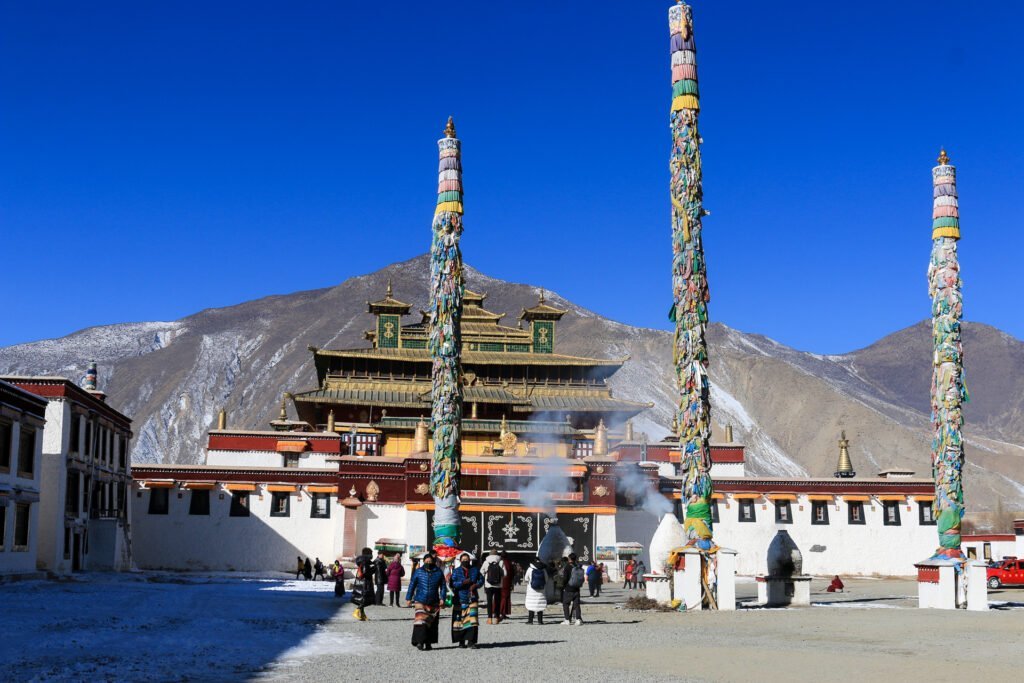Trisong Detsen, the 38th monarch of the Tibetan Empire, was instrumental in unifying Tibet and laying the foundation for the widespread practice of Buddhism. His reign, spanning from 755 to 797 AD, is often considered a golden era for Tibetan Buddhism. However, the story behind his name and rule is complex, with varying historical interpretations, particularly in Chinese records. This article explores his political and religious influence, the persecution and revival of Buddhism during his time, and his long-lasting impact on Tibet.
The Origin of Trisong Detsen’s Name
The naming of Trisong Detsen is a fascinating tale rooted in both legend and historical documentation. According to the Tibetan text The Banquet of the Sages, when he was just one year old, the court officials debated over his name. In a miraculous turn of events, the prince supposedly named himself, proclaiming divine authority over Tibet. However, more credible sources, such as the Dunhuang Manuscripts, suggest that his name was officially bestowed upon him by his ministers in 756 AD, marking the beginning of his reign. The name Trisong Detsen symbolizes leadership and divine endorsement, reinforcing his authority as king.
Political Turmoil and Trisong Detsen’s Legacy
Trisong Detsen’s reign was far from peaceful. It was marked by significant political upheavals:
- Religious Conflict – The struggle between the indigenous Bon religion and Tibetan Buddhism created tensions among the ruling class.
- Succession Crisis – Disputes over the rightful heir to the throne fractured the kingdom, leading to internal power struggles.
Despite these challenges, Trisong Detsen’s most enduring legacy is his contribution to Tibetan Buddhism. He established Buddhism as Tibet’s state religion and played a pivotal role in its promotion. Under his patronage, Buddhist teachings, culture, and practices became deeply integrated into Tibetan society.

The Tragic Fate of Tride Tsugtsen and Early Persecution of Buddhism
The Assassination of Tride Tsugtsen
Tride Tsugtsen, Trisong Detsen’s father and the 37th king of Tibet, was mysteriously poisoned. Historical records suggest that due to Trisong Detsen’s young age, power fell into the hands of ambitious ministers who opposed Buddhism. Figures like Machen Pomdrag, who favored Bon traditions, used their influence to suppress Buddhist teachings.
Legal Suppression of Buddhism
During Trisong Detsen’s early reign, anti-Buddhist ministers issued a legal decree known as The Minor Code, which banned Buddhist practices. The law dictated that anyone found studying or promoting Buddhism would face exile. Temples, including Jokhang and Ramoche, were repurposed, and foreign monks were expelled from Tibet.
Desecration of Buddhist Sites
Machen Pomdrag, a powerful anti-Buddhist minister, committed shocking acts against Buddhism:
- Machen Pomdrag desecrated Buddhist statues by placing animal intestines around their necks.
- He outlawed Buddhist funerary rites and expelled Indian Buddhist scholars, halting the translation of sacred texts.
- Minister ordered the removal of Buddhist statues from temples like Ramoche, attempting to return them to their countries of origin. However, a famous account states that a statue of Shakyamuni Buddha mysteriously became immovable, preventing its removal.
The Revival of Buddhism Under Trisong Detsen
Overcoming Opposition
As Trisong Detsen matured, he actively worked to revive Buddhism and weaken the influence of the anti-Buddhist ministers. He sought counsel from Buddhist-supporting officials such as Selang and Sambhu. His opposition to figures like Machen Pomdrag grew, leading to a covert operation that resulted in Machen Pomdrag’s death.
Restoring Buddhism’s Influence
After securing his authority, Trisong Detsen publicly reinstated Buddhism in Tibet. He recovered the revered statue of Shakyamuni Buddha and reinstated it in Jokhang Temple. He proclaimed that Buddhism’s suppression had been a grave mistake and pledged to restore it as Tibet’s guiding spiritual force.
Invitation of Indian Buddhist Masters
To further Buddhism’s development, Trisong Detsen invited renowned Indian scholars:
- Shantarakshita – A great Buddhist philosopher who introduced monastic discipline to Tibet.
- Padmasambhava – The tantric master credited with subduing demonic forces hindering Buddhism’s progress in Tibet.
These efforts culminated in historic debates between Buddhist scholars and Bon practitioners, solidifying Buddhism’s prominence in Tibet.

The Construction of Samye Monastery
Trisong Detsen played a direct role in establishing one of Tibet’s most significant religious landmarks: Samye Monastery. Completed in 775 AD, it became the first Buddhist monastery in Tibet, modeled after Indian monastic architecture.
The Legend of Samye’s Name
According to legend, Trisong Detsen was eager to see the monastery before its completion. Padmasambhava used his mystical powers to project an illusory image of the finished monastery. The astonished king exclaimed, “Samye!” meaning “inconceivable,” which became the monastery’s name.
Samye Monastery became a major center for Buddhist learning, where Indian, Chinese, and Tibetan scholars collaborated on translating sacred texts.
The Spread of Buddhist Teachings
Trisong Detsen took further steps to institutionalize Buddhism in Tibet:
- King sent Thonmi Sambhota to India, who later developed the Tibetan script and translated Sanskrit Buddhist texts.
- He initiated the first Tibetan translation of Buddhist scriptures, laying the groundwork for the Kangyur and Tengyur collections.
- Trisong Detsen established public teachings on Buddhist philosophy, making it accessible to Tibetan society.
Trisong Detsen’s Enduring Influence
The impact of Trisong Detsen’s reign extended far beyond his lifetime. His commitment to Buddhism:
- Strengthened Tibetan Identity – Buddhism became a defining feature of Tibetan culture and governance.
- Influenced Neighboring Regions – His patronage of Buddhist scholars and translation efforts influenced Buddhism in Mongolia and China.
- Left a Lasting Spiritual Legacy – He is revered as one of the three Dharma Kings of Tibet, alongside Songtsen Gampo and Ralpachen.
Conclusion
Trisong Detsen’s reign was a defining period in Tibetan history. From unifying Tibet under a single ruler to transforming it into a Buddhist stronghold, his contributions were unparalleled. Despite early suppression, his revival of Buddhism shaped Tibet’s cultural and spiritual landscape for centuries. Today, his legacy endures in the monasteries, scriptures, and spiritual traditions that define Tibetan Buddhism.
For more insights into Tibetan history and Buddhism, visit authoritative sources like Buddhistdoor and Himalayan Art Resources.

